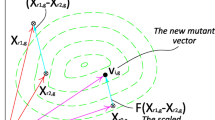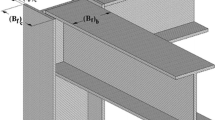Abstract
In this paper, a new design-driven hybrid optimization algorithm called guided evolution strategy (GES) is proposed for a reliable and rapid optimum design of space steel frames. The rationale behind the proposed GES algorithm is to improve convergence characteristics of the evolution strategies (ESs) optimization method by guiding search process according to the satisfaction/violation of strength constraints in a previous design. This is referred to as guided mutation, which is introduced as an auxiliary tool to a stochastic mutation scheme for accelerating the convergence speed of the optimization algorithm. The efficiency of the GES algorithm is investigated and quantified using design examples where sizing optimization of two space steel frames are achieved under strength and displacement constraints imposed according to ANSI/AISC 360-10 (Specification for structural steel buildings, ANSI/AISC 360-10, Illinois, 2010) and ASCE/SEI 7-10 (Minimum design loads for buildings and other structures, ASCE/SEI 7-10, Reston, 2010) design specifications. The solutions produced to these design examples with the GES algorithm are compared to those of some selected metaheuristic search techniques in terms of accuracy of the obtained solutions as well as speed of convergence to the optimum designs. It is shown that the GES algorithm has improved search abilities with respect to other employed techniques.









Similar content being viewed by others
References
Ahrari A, Atai AA (2013) Fully stressed design evolution strategy for shape and size optimization of truss structures. Comput Struct 123:58–67
Ahrari A, Deb K (2016) An improved fully stressed design evolution strategy for layout optimization of truss structures. Comput Struct 164:127–144
Ahrari A, Atai AA, Deb K (2015) Simultaneous topology, shape and size optimization of truss structures by fully stressed design based on evolution strategy. Eng Optim 47(8):1063–1084
ANSI, AISC 360-10 (2010) Specification for structural steel buildings. ANSI, AISC 360-10, Illinois
ASCE, SEI 7–10 (2010) Minimum design loads for buildings and other structures. ASCE, SEI 7–10, Reston
Aydoğdu İ, Akın A, Saka MP (2016) Design optimization of real-world steel space frames using artificial bee colony algorithm with levy flight distribution. Adv Eng Softw 92:1–14
Bäck T, Schütz M (1995) Evolutionary strategies for mixed-integer optimization of optical multilayer systems. In: McDonnel JR, Reynolds RG, Fogel DB (eds) Proceedings of the fourth annual conference on evolutionary programming. MIT Press, Cambridge, pp 33–51
Cai J, Thierauf G (1993) Discrete structural optimization using evolution strategies. In: Topping BHV, Khan AI (eds) Neural networks and combinatorial optimization in civil and structural engineering. Civil-Comp, Edinburgh, pp 95–100
Degertekin SO, Tutar H (2022) Optimized seismic design of planar and spatial steel frames using the hybrid learning based Jaya algorithm. Adv Eng Softw 171:103172
Elvin A, Walls R, Cromberge D (2009) Optimising structures using the principle of virtual work. J S Afr Inst Civil Eng 51(2):11–19
Erol OK, Eksin I (2006) A new optimization method: big bang–big crunch. Adv Eng Softw 37(2):106–111
Gallagher RH, Zienkiewicz OC (1973) Optimum structural design: theory and applications. Wiley, London
Gholizadeh S, Baghchevan A (2017) Multi-objective seismic design optimization of steel frames by a chaotic meta-heuristic algorithm. Eng Comput 33(4):1045–1060
Gholizadeh S, Fattahi F (2014) Design optimization of tall steel buildings by a modified particle swarm algorithm. Struct Des Tall Spec Build 23(4):285–301
Gholizadeh S, Milany A (2018) An improved fireworks algorithm for discrete sizing optimization of steel skeletal structures. Eng Optim 50(11):1829–1849
Hasançebi O (2007) Discrete approaches in evolution strategies based optimum design of steel frames. Struct Eng Mech 26(2):191–210
Hasançebi O, Kazemzadeh Azad S (2012) An exponential big bang-big crunch algorithm for discrete design optimization of steel frames. Comput Struct 110–111:167–179
Hasançebi O, Çarbaş S, Doğan E, Erdal F, Saka MP (2010) Comparison of non-deterministic search techniques in the optimum design of real size steel frames. Comput Struct 88(17–18):1033–1048
Hasançebi O, Bahçecioǧlu T, Kurç Ö, Saka MP (2011) Optimum design of high-rise steel buildings using an evolution strategy integrated parallel algorithm. Comput Struct 89(21–22):2037–2051
Kashani AR, Camp CV, Rostamian M, Azizi K, Gandomi AH (2022) Population-based optimization in structural engineering: a review. Artif Intell Rev 55:345–452
Kaveh A, Bakhshpoori T, Azimi M (2015) Seismic optimal design of 3D steel frames using cuckoo search algorithm. Struct Des Tall Special Build 24(3):210–227
Kazemzadeh Azad S (2021) Design optimization of real-size steel frames using monitored convergence curve. Struct Multidisc Optim 63(1):267–288
Kazemzadeh Azad S, Hasançebi O (2015) Computationally efficient discrete sizing of steel frames via guided stochastic search heuristic. Comput Struct 156:12–28
Kazemzadeh Azad S, Hasançebi O, Kazemzadeh Azad S (2013) Upper bound strategy for metaheuristic-based design optimization of steel frames. Adv Eng Softw 57:19–32
Kennedy J, Eberhart R (1995) Particle swarm optimization. In: Proceedings of ICNN'95-international conference on neural networks. IEEE Press, vol 4, pp 1942–1948
Korucu A (2022) Developing a structural optimization software for efficient and practical optimum design of real-world steel structures. PhD Thesis, Middle East Technical University, Ankara
Lamberti L, Pappalettere C (2011) Metaheuristic design optimization of skeletal structures: a review. Comput Technol Rev 4:1–32
Murren P, Khandelwal K (2014) Design-driven harmony search (DDHS) in steel frame optimization. Eng Struct 59:798–808
Nouhi B, Jahani Y, Talatahari S, Gandomi AH (2022) A swarm optimizer with modified feasible-based mechanism for optimum structure in steel industry. Decis Anal J 5:9
Patnaik SN, Berke L, Gallagher RH (1991) Integrated force method versus displacement method for finite element analysis. Comput Struct 38(4):377–407
Patnaik SN, Gendy AS, Berke L, Hopkins DA (1998) Modified fully utilized design (MFUD) method for stress and displacement constraints. Int J Numer Methods Eng 41(7):1171–1194
Razani R (1965) Behavior of fully stressed design of structures and its relationship to minimum-weight design. AIAA J 3(12):2262–2268
Rechenberg I (1965) Cybernetic solution path of an experimental problem. Royal Aircraft Establishment Library Translation 1122
Rechenberg I (1973) Evolutionsstrategie: Optimierung Technischer Systeme nach Prinzipien der Biologischen Evolution [Evolution strategy: optimization of technical systems according to the principles of biological evolution]. Frommann-Holzboog Verlag, Stuttgart
Renkavieski C, Parpinelli RS (2021) Meta-heuristic algorithms to truss optimization: Literature mapping and application. Expert Syst Appl 182:115197
Rudolph G (1994) An evolutionary algorithm for integer programming. In: Davidor Y, Schwefel H-P, Manner R (eds) Proceedings of third conference on parallel problem solving from nature. Springer, Heidelberg, pp 139–148
Sadrekarimi N, Talatahari S, Azar BF, Gandomi AH (2023) A surrogate merit function developed for structural weight optimization problems. Soft Comput 27(3):1533–1563
Saka MP (2007) Optimum design of steel frames using stochastic search techniques based on natural phenomena: a review. In: Topping BHV (ed) Civil engineering computations: tools and techniques. Saxe-Coburg Publications, Stirlingshire, pp 105–147
Saka MP, Geem ZW (2013) Mathematical and metaheuristic applications in design optimization of steel frame structures: An extensive review. Math Probl Eng 2013:271031
Schwefel H-P (1965) Kybernetische Evolution als Strategie der Experimentellen Forschung in der Strömungstechnik. Diplomarbeit, Technische Universität, Berlin
Schwefel H-P (1977) Numerische Optimierung von Computer-Modellen mittels der Evolutionsstrategie. Vol. 26, Interdisciplinary system research. Birkhäuser Verlag, Basel
Schwefel H-P (1981) Numerical optimization of computer models. Wiley, Chichester
Tabak EI, Wright PM (1981) Optimality criteria method for building frames. J Struct Div 107(7):1327–1342
Talatahari S, Azizi M (2020) Optimal design of real-size building structures using quantum-behaved developed swarm optimizer. Struct Des Tall Spec Build 29(11):e1747
Talatahari S, Jalili S, Azizi M (2021) Optimum design of steel building structures using migration-based vibrating particles system. Struct 33:1394–1413
Talatahari S, Veladi H, Azizi M, Moutabi-Alavi A, Rahnema S (2022) Optimum structural design of full-scale steel buildings using drift-tribe-charged system search. Earthq Eng Eng Vib 21(3):825–842
Turkey Council of Higher Education (2023) Thesis Center, https://tez.yok.gov.tr/UlusalTezMerkezi/tarama.jsp. Accessed 25 Apr 2023
Walls R, Elvin A (2010) Optimizing structures subject to multiple deflection constraints and load cases using the principle of virtual work. J Struct Eng 136(11):1444–1452
Yang XS (2010) Nature-inspired metaheuristic algorithms. Luniver Press, Beckington
Acknowledgements
The authors would like to thank Dr. Hasan Eser from Middle East Technical University for providing the finite element models of the steel frames used in this study.
Author information
Authors and Affiliations
Corresponding author
Ethics declarations
Conflict of interest
The author declares that he has no known competing financial interests or personal relationships that could have appeared to influence the work reported in this paper.
Replication of results
The data for producing the presented results will be made available upon request.
Additional information
Responsible Editor: Gang Li
Publisher's Note
Springer Nature remains neutral with regard to jurisdictional claims in published maps and institutional affiliations.
Supplementary Information
Below is the link to the electronic supplementary material.
Rights and permissions
Springer Nature or its licensor (e.g. a society or other partner) holds exclusive rights to this article under a publishing agreement with the author(s) or other rightsholder(s); author self-archiving of the accepted manuscript version of this article is solely governed by the terms of such publishing agreement and applicable law.
About this article
Cite this article
Korucu, A., Hasançebi, O. A guided evolution strategy for discrete sizing optimization of space steel frames. Struct Multidisc Optim 66, 183 (2023). https://doi.org/10.1007/s00158-023-03640-7
Received:
Revised:
Accepted:
Published:
DOI: https://doi.org/10.1007/s00158-023-03640-7




